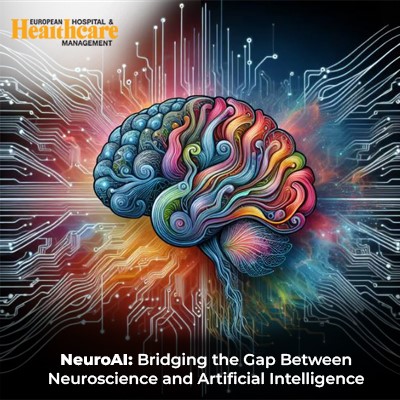NeuroAI, the fusion of neuroscience and artificial intelligence (AI), holds immense potential in revolutionizing fields like healthcare, robotics, and autonomous systems. This article explores NeuroAI's concept, applications, challenges, and future directions, emphasizing the need for ethical governance to harness its full benefits responsibly.

NeuroAI, the fusion of neuroscience and artificial intelligence (AI), represents a frontier where the understanding of the human brain meets the computational power of machines. This synergy has the potential to revolutionize various fields, from healthcare to robotics, by unlocking insights into how the brain processes information and adapts to its environment. In this article, we delve into the concept of NeuroAI, its applications, challenges, and the future it promises.
At its core, NeuroAI aims to mimic the intricate workings of the human brain within AI systems. This involves not only replicating neural networks but also incorporating principles of cognition, learning, and adaptation observed in biological systems. By drawing inspiration from neuroscience, AI researchers seek to develop more efficient and intelligent algorithms that can perform complex tasks with human-like capabilities.
One of the fundamental aspects driving NeuroAI is the concept of neural networks. These computational models, inspired by the structure of the brain's neural networks, consist of interconnected nodes (neurons) that process and transmit information. Through deep learning techniques, neural networks can learn from vast amounts of data, recognize patterns, and make predictions, mimicking the brain's ability to learn and adapt.
The potential applications of NeuroAI are vast and span across various domains:
Healthcare
In healthcare, NeuroAI holds promise for personalized medicine, disease diagnosis, and treatment optimization. AI algorithms trained on neuroimaging data can assist in early detection of neurological disorders such as Alzheimer's disease, stroke, and epilepsy. Moreover, NeuroAI-powered systems can analyze genetic data to tailor treatments based on individual patients' genetic profiles, optimizing therapeutic outcomes.
Robotics and Prosthetics
NeuroAI is transforming robotics by enabling machines to interact with their environment more intuitively. Brain-computer interfaces (BCIs) leverage NeuroAI to decode neural signals and translate them into commands for prosthetic limbs or robotic devices, offering new possibilities for individuals with disabilities to regain mobility and independence.
Autonomous Vehicles
The integration of NeuroAI in autonomous vehicles enhances their decision-making capabilities. By mimicking human perception and learning mechanisms, AI systems can better interpret complex driving scenarios, anticipate potential hazards, and make real-time adjustments, ultimately improving safety and efficiency on the roads.
Natural Language Processing (NLP)
In NLP, NeuroAI is advancing language understanding and generation. Neural language models trained on vast text corpora exhibit human-like fluency and context awareness, powering applications such as virtual assistants, language translation, and sentiment analysis with greater accuracy and nuance.
Cognitive Computing
NeuroAI is driving advancements in cognitive computing, where AI systems can reason, plan, and make decisions in complex and dynamic environments. This has implications for business analytics, financial modeling, and strategic planning, where AI-driven insights can guide decision-makers more effectively.
While the potential of NeuroAI is exciting, several challenges and ethical considerations must be addressed:
Data Privacy and Security
The use of neural data and biometric information in NeuroAI raises concerns about data privacy and security. Safeguarding sensitive neurological data and ensuring ethical use of such data in AI systems are paramount to maintaining trust and transparency.
Bias and Fairness
AI algorithms, including those inspired by neuroscience, are susceptible to bias based on the data they are trained on. Addressing biases and ensuring fairness in NeuroAI applications, particularly in areas like healthcare and law enforcement, is crucial to avoid perpetuating societal inequalities.
Interpretability and Explainability
The complexity of neural networks in NeuroAI often leads to challenges in interpreting and explaining their decisions. Enhancing the interpretability and explainability of AI models is essential for building trust among users, regulators, and stakeholders.
Ethical AI Governance
Developing frameworks for ethical AI governance is essential to guide the responsible development and deployment of NeuroAI technologies. This includes considerations such as accountability, transparency, and inclusivity in AI systems' design and implementation.
Looking ahead, the future of NeuroAI is filled with possibilities:
Brain-Inspired Computing
Advances in neuromorphic computing, inspired by the brain's architecture, are paving the way for more energy-efficient and scalable AI systems. Neuromorphic chips and architectures mimic the parallel processing and low-power consumption of biological brains, offering new avenues for AI hardware development.
Cognitive Enhancement
NeuroAI has the potential to enhance human cognition through brain-computer interfaces and neurofeedback systems. These technologies could augment learning, memory, and decision-making processes, leading to new frontiers in human-machine collaboration and cognitive augmentation.
Neuroethical Frameworks
The development of neuroethical frameworks is critical for navigating the ethical, legal, and societal implications of NeuroAI. Multidisciplinary collaborations involving neuroscientists, ethicists, policymakers, and technologists are essential for shaping responsible practices and policies in NeuroAI research and application.
AI-Driven Neuroscience
On the flip side, AI techniques are also influencing neuroscience research. AI algorithms are helping neuroscientists analyze complex brain data, uncover neural patterns, and gain deeper insights into brain functions and disorders, fostering synergies between AI and neuroscience disciplines.
NeuroAI represents a convergence of scientific disciplines with profound implications for society. By bridging the gap between neuroscience and artificial intelligence, NeuroAI opens doors to new frontiers in healthcare, robotics, autonomous systems, and cognitive computing. However, addressing challenges such as data privacy, bias, interpretability, and ethical governance is crucial to harnessing NeuroAI's full potential responsibly. As research and innovation in NeuroAI continue to accelerate, it is essential to foster interdisciplinary collaborations and ethical frameworks that ensure its development and deployment benefit humanity.